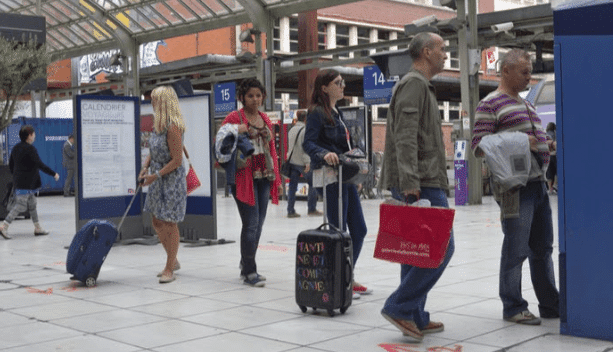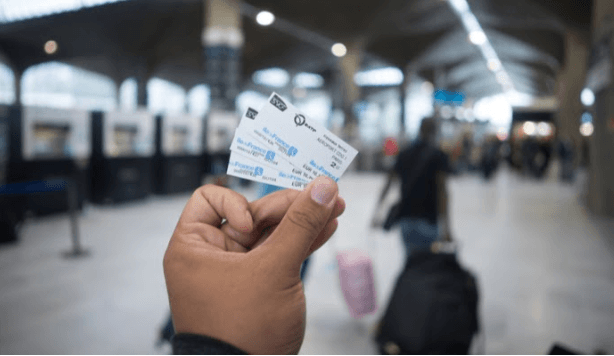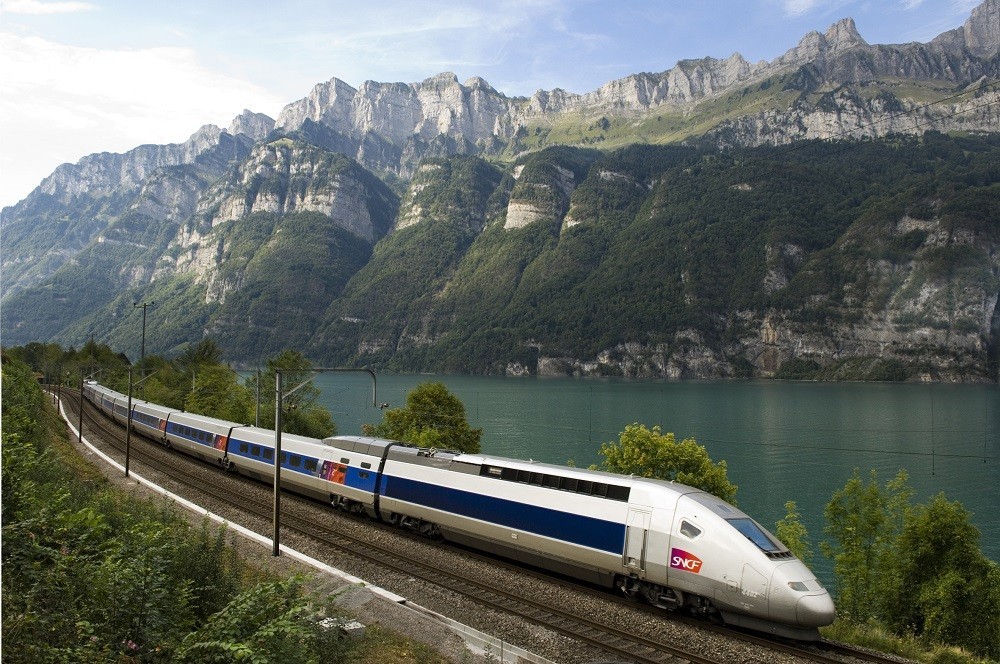The Complete Guide To Travel In France By Train
(Last Updated On: 01/04/2021)
France has long been a favorite and one of the most popular tourist destinations in Europe. Given that it is the largest country in western Europe, it makes sense to travel by train. The French government has invested in high-speed lines (Ligne a Grande Vitesse or LGV) and high-speed trains (Train a Grande Vitesse or TGV train). There are more than 1056 miles (1700 km) of dedicated high-speed lines as well as thousands of miles of main and smaller lines. Almost the whole country is accessible via French railways. France’s trains are efficient, fast, and will get you where you want to go within the country as well as to or from any neighboring country. If you are a first-time traveler in France, the best way to get around using train travel is through careful trip planning. However, the rail network can be a little confusing, especially when you don’t speak or read French. To help you understand the train system in France, we have created a complete guide to travel throughout France by train.
In this guide, you will find out everything you need to know to create your personal travel plan. We will also provide information on different train companies that operate in France and the types of trains. We will give you valuable tips on buying tickets for the lowest price, navigating the railway system, the benefits of rail passes, and getting around France from Paris. Keep reading The Complete Guide To Travel In France By Train to discover how to travel to France by train.
- Rail Transport Is The Eco-Friendly Way To Travel. This article is written to educate about Train Travel by Save A Train, The Cheapest Train Tickets Website In The World.
How To Buy Train Tickets In France
Where can I buy train tickets for my trip to France?
There are several easy and convenient methods or websites for buying French train tickets. They are fairly easy to use, but many of them come with their own quirks and oddities that we need to point out.
Save a Train is a company that digitized and revolutionized rail ticketing. Visit their website, compare train fares, choose the train line, and type of seat you want. You can pay with your credit card or even bitcoin. In case your train ticket’s price drops, the platform will let you know and help you exchange it for a lower price.
When accessing the official website of French Railways, you will most probably get redirected to RailEurope.com, which is the official North American partner of French Railways. However, you won’t always find the cheapest fares on Rail Europe. Therefore, you should always pay attention that the cheapest train route fares are on Save A Train.

At The Train Station
There are two ways to buy French train tickets at the station – from a ticket window and at the vending machine. English-speakers can purchase them either way, but if your English is not that good and cannot communicate with the person at the ticket window well, the vending machine is your best bet. It is easy to navigate, and you can even change its language settings. Buying tickets from the vending machine requires a Chip & PIN credit card.
How should I collect my online ticket?
There are several methods of collecting your tickets:
- Pick up at the station. To collect your tickets at the station, you can use a booking information number or credit card (the same one you used to buy the tickets).
- Print-at-home tickets. After you receive the electronic tickets, you can print them and show them to the train conductor who checks tickets.
- Electronic tickets. If you don’t want to print your tickets, you can download them to your phone or tablet. You can just show the conductor your ticket via your phone or tablet screen.
- Mailed tickets. Some services offer the option of sending you the tickets via regular mail. However, that is a very slow process, and therefore, not a recommended option.
Should I buy train tickets in advance?
It can be confusing to know which train tickets can be purchased whenever and which should be bought in advance because there are several types of trains and different train services.
Regional/local trains. Regional and local trains connect suburban and regional areas. RER and Transilien connect suburban Paris, while TER trains (Train Expres Regionaux) are regional trains that connect regional hubs with smaller towns. You don’t have to buy regional and local train tickets in advance, just buy them right before departure.
- Intercite trains (IC). An Intercites train is an express train that doesn’t travel on the high-speed lines and connects cities as well as shorter distances. You can purchase IC tickets in advance to get a discount.
- High-speed trains (TGV). TGV trains are the fastest trains in France, and tickets for them are available to purchase 90 days in advance. The prices for them continue to rise as the departure date approaches, so book them early for the lowest price. A ticket purchased 90 days in advance could cost €30. But if you were to buy them a few days before the departure, the ticket price could be as high as €100.
- International trains. The same rules on early booking apply to international trains because these are also high-speed trains.
What are the benefits of rail pass tickets?
There’s a wide range of rail pass tickets you can use to travel throughout France by train. Some of them allow you to travel within France and other European countries, and then there are rail passes that are solely for travel within France. Unlike regular train tickets, rail pass tickets come with some benefits:
- Flexibility. With a rail pass ticket, you get unlimited train travel. Just go to the station whenever you like, stamp the rail pass in the train station office and get on the next available train.
- Discounts. Rail passes typically come with inclusions of discounts for attractions, making them an excellent option for budget travelers. They can be a huge money-saver, which is the main reason people purchase rail passes. Last-minute train tickets can be costly if you don’t book them in advance.
- Convenience. You don’t need to worry about buying a ticket every time you want to take a train, but you must have flexibility since you won’t have a place on every train that you wish.
Which rail pass ticket should I purchase?
When purchasing a rail pass ticket, you can choose between the France Country Pass and Multi-Country Pass (Eurail Global Pass).
The France Country Pass is your best bet if you are just traveling in France because it provides unlimited travel on the national rail network (including intercity, TER, TGC, etc.). You can choose either 1 to 8 days of travel within a month as well as choose between first and second class. A seat reservation is required in addition to a rail pass for travel on high-speed trains. With this pass, you also receive discounts on various buses, ferries, cruises, hotels, museums, and other attractions.
The Eurail Global Pass is a better option if you also plan to travel to neighboring countries. This multi-country pass provides unlimited travel to 31 different countries in Europe (including France). With Eurail passes, there is no limit to the number of times you can catch a train. Choose either 3, 5, or 7 days of travel within one month or 10-15 days of travel within two months. Remember to make reservations before departure.
Most rail passes are paper-based, and you will need to write the date of your departure before the first trip of each day. Seat reservations for high-speed trains will cost you between €10 and €20 per seat, while international travel reservations range from €35 to €89 per seat (depending on the destination).
AN IMPORTANT NOTE: Rail Pass is only good value for money if you train travel to more than 14 days if you travel for less than point to point train tickets such as what Save A Train is offerings offer better value for your money.
Marseilles to Lyon Train times
How To Use Train Tickets In France?
On regional and local trains, you might need to travel with a physical ticket. Go to a validation box before your departure to validate or “stamp” your ticket. If you didn’t validate it before departure, wait for the conductor to stamp it while on the train. There are no seat reservations for regional and local trains, so just sit anywhere.
On high-speed trains, there is a specific time printed on your ticket, and the ticket is only valid for that specified time. There is no need to validate your tickets because you have a seat reservation. Make sure that you find the right car and seat (the numbers are written or printed on your ticket).

Getting Around France From Paris
When tourists come to France, the majority of them make Paris their starting point for train journeys within the country. When starting in Paris, you can reach almost any destination within the country. These are some of the main destinations served from Parisian train stations.
- Gare d’Austerlitz or Austerlitz Train Station – Bordeaux, Limoges, Poitiers, Toulouse, Biarritz, Tours, and western Spain.
- Montparnase Train Station or Gare Montparnasse – All TGVs to western France (Rennes, Nantes, Brest, Brittany)
- Gare du Nord – Northeast France, Valenciennes, Lille, Calais; Brussels, Cologne, and Amsterdam (Thalys); London (Eurostar).
- Gare de Lyon – South of France. Montpellier, Dijon, Lyon, Clermont-Ferrand, Besançon, Marseille, Nice. Mulhouse in the East of France. Catalunya (Girona, Barcelona), Italy, and Switzerland (Geneva, Zurich).
- Saint Lazare Railway Station or Gare St. Lazare – Le Havre, Rouen, Caen, Cherbourg.
- Gare de l’Est – Nancy. Reims, Metz, Strasbourg, Luxembourg, and Germany.
Toulouse to La Rochelle Trains
Bordeaux to La Rochelle Trains
Best Tips For Travel In France By Train
We provide you with a list of great tips that will make your train travel in France more convenient and enjoyable.
- Arrive early at the train station. Be sure to be at the train station at least 20 minutes before departure, or even earlier if you are traveling from huge train stations, such as the Gare du Nord in Paris. For a tourist who doesn’t speak French, there is nothing worse than arriving only a few minutes before departure without having the slightest idea of where to go. Arriving early enough will give you time to check the Departure Board for station information, identify which platform your train is leaving, and find the right platform.
- Never leave your luggage unattended. You might want to walk to a nearby shop for some snacks or water. If you decide to walk around, don’t leave your bag unattended even for a second. Otherwise, you risk having your luggage stolen by experienced thieves. Major train stations in France (including Paris Gare du Nord, Paris Gare de Lyon, and Paris Gare d’Austerlitz Est) have left-luggage lockers in various sizes. Before you enter the locker area, expect to have your bags X-rayed. Once onboard, place your luggage within your eyesight instead of on the dedicated luggage spaces.
- Pack some food. Passengers are allowed to bring their own food and beverage on trains, which is great for long-distance train rides. Some trains have a cafe on board, and most of them have a trolley cart that comes around. Unfortunately, the trolley doesn’t always come, and the cafe may be closed. The food and drinks on board are also more expensive. To save money, pack yourself a picnic with your favorite food before every trip. There are various convenience stores in most train stations where you can buy food and drinks.
- Download a rail planner app to your phone. There is a range of rail planner apps you can install and use to make your train travels more convenient. Our article contains all the info and train schedules for European trains, and some apps don’t require an internet connection. With a rail planner app, you will always know whether your train is going to be late (and by how long) or on time, as well as which platform it will arrive/depart. In major cities like Paris, there isn’t one “main” station, and it is easy to confuse one station for another. With the right app, you will be sure that you get off at the correct station.
- Luggage. When it comes to luggage, you can bring as much as you can carry since there are no weight limits. You can store your bags overhead, behind your seat, or in a luggage rack in your car.
- First-class and second-class tickets. There is not much difference between first-class and second-class cars. However, it is quieter in the first-class, and the seats are a bit bigger. Second-class cars are also perfectly comfortable. It’s worth mentioning that first-class tickets cost about 1.5x more than the second-class fare.
- You cannot refund cheap tickets. Perhaps the only downside to cheap tickets is that they cannot be changed or refunded.
- Self-service machines. When using a self-serving ticket machine, you can choose the English language option, so there’s no need to worry if you don’t speak French.
- Carrying a bicycle. On local and regional trains, you can take a bicycle with you free of charge. TGVs and Intercites de Nuit (overnight trains) on a few routes allow you to take a bike for a small fee (usually about €10). On other TGV trains, you will have to put your bicycle in a zip-up bike bag.
- Making connections. Along the journey, your trip might require you to change trains. Switching trains are typically quick and easy, so there’s no need to worry if you don’t have enough time between trains. A train connection might involve walking to the other side of the platform or the other part of the train station.
- Know the train station names. Large cities have multiple train stations, which can create confusion. If you can’t memorize their names, write them down on a piece of paper, save them on your phone, or use a rail planner app.
- Mind the train strikes. France is known for train strikes, and they always warn the public before going on one. While some trains will still run, strikes are something to pay attention to if you want to avoid major inconveniences.
- Use Chip & PIN credit card. To purchase a ticket on an automated ticket kiosk, you will need a Chip & PIN credit card, so make sure you know your PIN code, although we do not recommend it, since it’s very expensive.
Marseilles to Clermont Ferrand Trains

All major cities in France are connected by TGV – the high-speed train network with trains that travel at speeds of nearly 200 mph. At these speeds, all areas of France are within your reach.
We designed this guide “Complete Guide To Travel In France By Train” to give you a strong understanding of how the French rail system works and help you if you are thinking about taking a train but not sure what to do or where to start. Whether you are on a backpacking adventure, a business trip, or on a family holiday, we have got you covered, Save A Train is the place to buy train tickets.
Do you want to embed our blog post “The Complete Guide To Travel In France By Train” onto your site? You can either take our photos and text and give us credit with a link to this blog post. Or click here: https://iframely.com/embed/https%3A%2F%2Fwww.saveatrain.com%2Fblog%2Fguide-travel-france-train%2F%3Flang%3Den - (Scroll down a little to see the Embed Code)
- If you want to be kind to your users, you can guide them directly into our search pages. In this link, you will find our most popular train routes – https://www.saveatrain.com/routes_sitemap.xml. Inside you have our links for English landing pages, but we also have https://www.saveatrain.com/fr_routes_sitemap.xml, and you can change the /fr to /it or /es and more languages.




